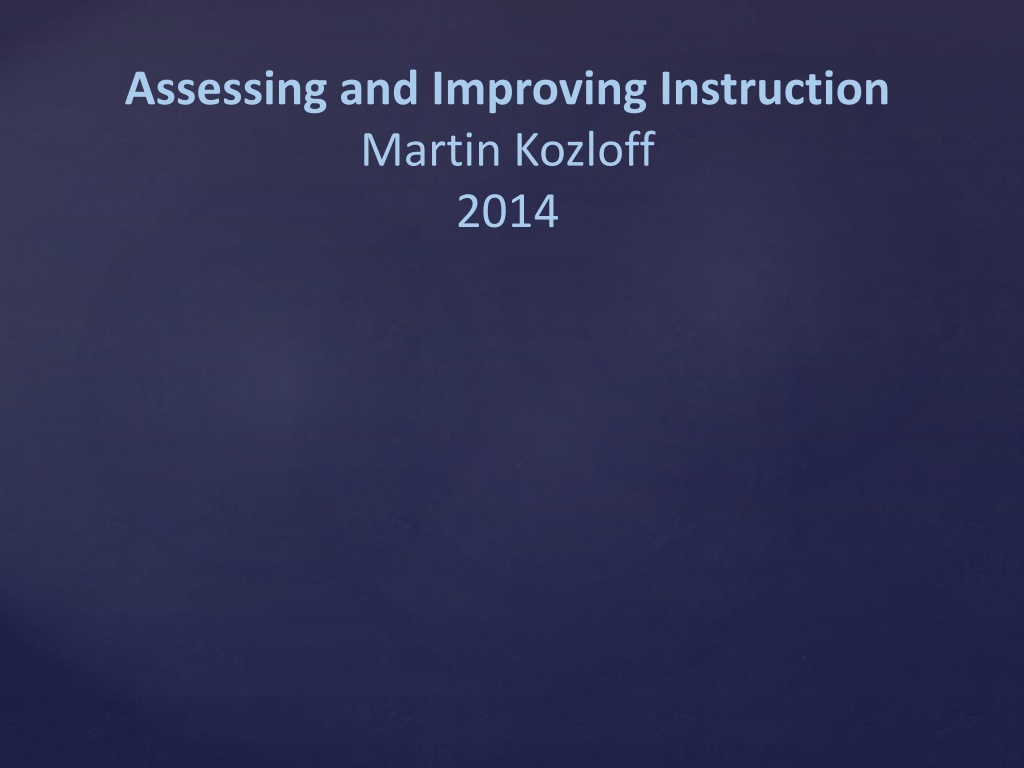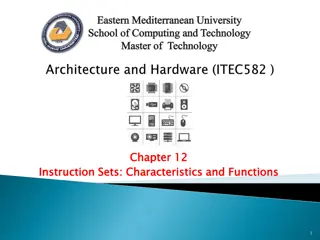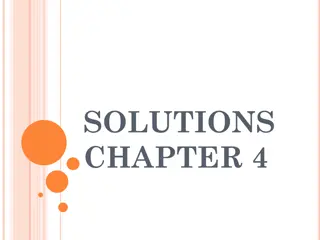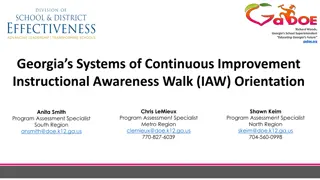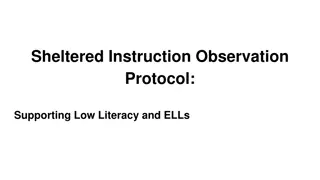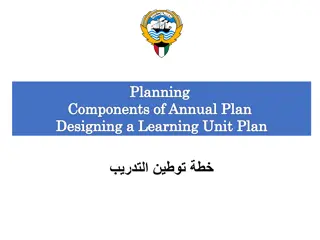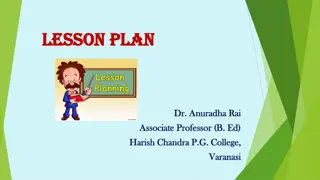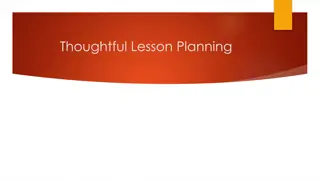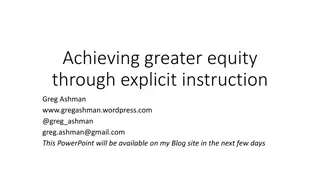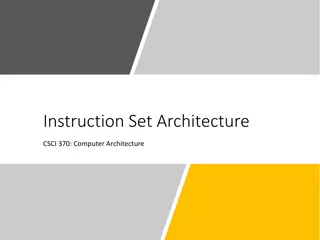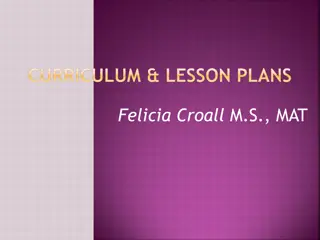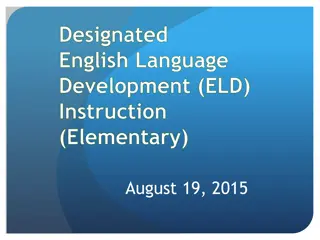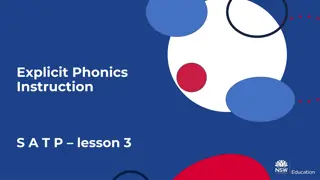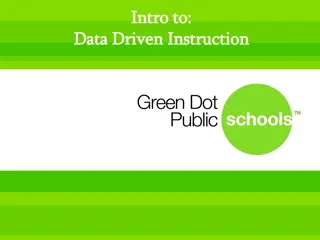Strategies for Effective Instruction and Lesson Planning
This guide emphasizes maximizing teaching time, using productive grouping, preparing students for new material, designing instruction around objectives, and organizing lessons effectively. It highlights the importance of scaffolding instruction, reviewing previous knowledge, modeling new information, and providing immediate feedback. The strategies cover various instructional formats and phases of mastery, aiming to enhance student learning and retention.
Download Presentation

Please find below an Image/Link to download the presentation.
The content on the website is provided AS IS for your information and personal use only. It may not be sold, licensed, or shared on other websites without obtaining consent from the author. Download presentation by click this link. If you encounter any issues during the download, it is possible that the publisher has removed the file from their server.
E N D
Presentation Transcript
Assessing and Improving Instruction Martin Kozloff 2014
Outline 1. Maximize time for teaching. 2. Use productive grouping in differentiated instruction. 3. Prepare student for new material being taught. Make sure they are firm on the pre-skill elements and/or background knowledge. 4. Prepare students for the start of each lesson and for the start of each new task in the lesson. 5. Design instruction on the basis of objectives: the performance (what students will do) and performance standards (how they will do it). 6. Prepare the lesson for delivery.
7. Lessons are a sequence of knowledge-rich tasks. Each task in a lesson has a clear instructional function. 8. Use the proper format for teaching each form of knowledge: facts, concepts, rule-relationships, routines. 9. Adequately teach and assess all phases of mastery: acquisition of new knowledge (initial instruction) fluency (accurate and quick), generalization (application to new examples), integration of elements into larger wholes, retention. 10. Organize lessons around this format. Seven-point lesson plan.
11. Plan ways to scaffold instruction ; i.e., various kinds of assistance to help teachers communicate information, and to help students acquire, organize, retrieve, and apply information/knowledge. 12. Begin instruction on a new lesson with review, especially of knowledge elements and background knowledge relevant to the current instruction (pre-skills). 13. Next in a lesson, frame the main business of the lesson by stating the kind of new knowledge to be taught, the objectives (final performance and standards), and big ideas. 14. Next in a lesson, model or present new information clearly and focus on the objectives.
15. If students are not likely to learn from the model alone, lead students through the application of the new information just modeled. 16. Use pre-corrections, or reminders, to prevent errors when it is students turn to respond. 17. After the model (and if used, the lead), give an immediate acquisition test/check to determine whether students learned the new information. 18. Correct all errors and/or firm weak knowledge after the lead and/or test/check.
19. If new material is a concept (e.g., mitosis), rule-relationship (e.g., how price varies with demand), or cognitive routine (e.g., a math algorithm), make sure to: (a) use a wide and varied range of examples; (b) juxtapose examples to reveal sameness; (c) juxtapose examples and nonexamples to reveal difference; (d) when teaching routines (sequences of steps), use a sequence of formats, from more to less teacher-modeled. 20. Give a delayed acquisition test/check to determine whether students learned the concept, rule relationship, or cognitive routine from the set of the examples and nonexamples. 21. Teach at a brisk pace, with enthusiasm. 22. End the lesson by reviewing the lesson (e.g., main things taught) and state how what was taught is relevant to next lessons. 23. Use frequent (every 5 to 10 lessons) curriculum-based progress monitoring assessments. Now let s look at each item in more detail.
Curriculum 1. A curriculum is all of the information, skills, or knowledge that students are to learn, and the sequence in which they are to learn it. Scope and sequence charts show what is taught and when.
Scope and Sequence (What and When) Chart for a Beginning Reading Curriculum Lessons 1 100 Hear sounds in words (phonemic awareness) |--------------| Sounds that go with letters (letter-sound correspondence: alphabetic principle) |-------------------------------------------------------| Decoding (sounding out unfamiliar words: alphabetic principle) |-----------------------------------------------------------| Fluency (reading letters, words, sentences, paragraphs fast and accurately) |-------------------------------------------------------------| Vocabulary |-------------------------------------------------------------| Text Comprehension |----------------------------------------------------------|
The sequence should be meaningful (make sense) and coherent (knowledge elements hang together). How to do this. 1. Organize the content (what is taught) and sequence around Big Ideas. For example: a. A theory of social change, for a course on history. The age of pioneers the age of conquest the age of commerce the age of affluence the age of intellect the age of decadence (Sir John Glubb. The fate of empires.) b. The concept of system, for a course on science.
c. The idea that poetry reflects and is shaped by the social setting of the poet. d. The idea that some groups want a strong government and other groups want a weak government 2. Organize content in a logical progression. For example: a. Time line. b. Story. c. Deductive: General idea followed by supporting facts. d. Inductive: Facts that reveal or from which students can induce (figure out) the general idea.
e. And in all curricula, teach knowledge elements before you teach larger routines that USE the knowledge elements. Knowledge analysis tells you what these elements are. (1) Sound out ram. What does student do/have to know? (2) Translate second paragraph of Declaration of Independence into a list of rule statements. What does student have to know?
Curriculum Lessons/ 1 .10 .35 ..50 90 days Unit 1 Unit 2 Unit 3 Unit 4 Lesson Task 1. Review and firm. Sequence of sentences. Task 2 New: facts, concepts, rules, routines. Task 3 More Task 4 Work on fluency and/or generalization Task 5 Integrate? Apply? Task 6 Review, firm, reteach Of course, instruction occurs within a curriculum. Here are the main units.
Note: there are objectives---performances and standards---for the whole curriculum, for each unit, for each lesson, and for each task in a lesson. Performance: What students will do. Standards/assessment: How students are to do the performance. Usually: a. Correct, such as percentage correct. b. Speed. Such as time; correct problems per minute. c. Completeness: steps completed, issues addressed.
If your materials do not state objectives for you, then you have to make them up. Where do you get objectives for a whole curriculum? 1. State, district, and school standards. 2. Research; e.g., on best practices in science. 3. Your own knowledge.
What about objectives for units, lessons, and tasks? Do a knowledge analysis of the objectives for the whole curriculum. Students describe how galaxies consist of solar systems, which consist of planets, which (in the case of earth) consist of ecosystems, which are influenced by a variety of other systems (geological, biological, sociological), which consist of life forms. Students define the following concepts: system, ecosystem, tectonics, . What do you have to teach for students to achieve those objectives?
In what sequence would you teach that content? These large chunks are your Units: 1. Systems. 2. Biological systems. 3. Ecosystems. 4. Earth as a system. 5. Solar system. 6. Galactic systems. Now, what are objectives for each unit? 1. System. Define system. What are main features of systems: structure and process? Give examples of systems and state their features. This is what you have to teach for Unit 1, in a sequence of lessons.
Each lesson teaches some of the knowledge needed to achieve the Unit objectives. For example, Lesson 1 of Unit 1 might give examples of systems--- atom, cell, organ, forest, marsh and then define system and tell the features. There would be objectives for this lesson. Give examples of systems. State the definition of system. State main features of systems. This is what you would teach in Lesson 1.
Each lesson is a sequence of Tasks. Each task focuses on a part of the knowledge needed for students to achieve the lesson (and therefore the Unit, and therefore the curriculum) objectives. For example, Task 1. Boys and girls. New concept. System. Spell system. Here s the definition of system. Look at your guided notes. A system is a group of interacting, interrelated, or interdependent elements forming a complex whole. say that definition . [Task objective] You
Task 2. Let s look at each part of that definition. You tell me the main words in it. [Task objective.] Elements Interacting Interconnected Complex whole Task 3. Now let s examine what these words mean, and see how they describe different kinds of systems. [Task objective is that students (a) define each of the system terms, and (b) use them to identify aspects of different systems. Here s a muscle cell. Name the elements .
Instruction 1. Maximize time for teaching. a. Have necessary materials readily available and at hand. b. Control noninstruction activities--- announcements and other interruptions. c. Use routines for distributing and collecting materials. Teach how; practice; do sprints.
2.Use productive grouping in differentiated instruction. a. Give pre-tests or placement tests (of what is taught throughout a curriculum) to place students in groups with other students at the same level or spot in a curriculum---homogeneous grouping. b. Keep the groups small say six to eight students. c. Move students to different groups based on progress monitoring information. d. Have lower performers seated close to you, and separate students with problematic behaviors.
3. Prepare student for new material being taught. Make sure they are firm on the pre-skill elements and/or background knowledge. These knowledge elements are determined by knowledge analysis; e.g., revealing the important concepts in a science passage; the concepts and rules needed to do each step in a math routine. Teach elements (pre-skills) early, and review/firm them continually before they are integrated into larger routines that USE the elements.
4. Prepare students for the start of each lesson and for the start of each new task in the lesson. a. Teach and practice having students get ready for learning. Show me ready. b. Get into lessons quickly, and give encouragement. Okay, we re ready to learn. Here we go. Remember, when you try hard, you get it! c. Reinforce attentive, effortful behavior. I love the way John is listening to Jerry read. d. Re-establish attention and participation immediately. I need to see everyone sitting ready. I need to hear EVERYbody!..... That s it. NOW we have everybody! My turn!
5. Design instruction on the basis of objectives a. What students will DO---not what they will know, appreciate, understand, or demonstrate), and b. HOW they will do it---performance standards such as accuracy, completeness, and speed. Focus communication precisely on objectives. No blather.
6. Prepare the lesson for delivery. a. Script portions that must be logically faultless, such as wording and examples in definitions, steps in routines (such as math and reading). b. Prepare places in your presentation for test/checks of student acquisition. So what do you do next? Remember to c. Anticipate specific errors or difficult tasks, and prepare to repeat models and the lead ( with me ); use pre-corrections (reminders) and information checks. For example, They are not yet firm with these definitions; so I ll review them first. Remind students of the rule on renaming. Ask students to repeat an instruction.
7. Lessons are a sequence of knowledge-rich tasks. Each task in a lesson has a clear instructional function. a. Teach something new (facts, concepts, rules, cognitive routines). [acquisition] New vocabulary word. Republic. Here are the steps in the routine for calculating slope and intercept. b. Summarize. The 9 events leading to the War of Independence are c. Build fluency. You can do these problems in 1 minute. The error limit is two. GO! d. Review and probe/test (retention). Let s review our concepts.
More instructional functions e. Expand---add more to existing facts, examples, concepts. f. Generalize knowledge to new examples. Here are new examples of linear functions. Calculate slope and intercept with the same routine as with earlier examples. g. Strategically integrate---combine information into a larger whole, such as an explanatory essay, or a research project, or a math routine. For example Teach what a linear function is. + >> Define data points as coordinates on X/Y axes. + >> Graph data points. + >> Explain the straight lines as examples of linear functions. +>> Show that all sections of a line (function) are the same in the ratio of change in Y over change in X. +>> Model, lead, test the sequence of steps in the routine for calculating the slope.
8. Use the proper format for teaching each form of knowledge, based on the logic of learning. We have a learning mechanism: sense organs and brain. The learning mechanism runs on logic. It does two things. a. The learning mechanism figures out what events mean. This is the construction of knowledge. The learning mechanism uses inductive logic. How? It compares and contrasts events; it sees how they are the same and different; it sees how some things go together and other things don t; it infers (induces, generalizes, figures out) that:
a. There are KINDS of things---classes, called concepts. Millions of classes/concepts make up the stuff in our reality. We don t see a configuration of colors and shapes. We see a member of the class/concept of table. We see reality through our concepts. The learning mechanism also learns that (or is told that) b. Individual examples of kinds of things have features. The dog is brown. Facts. The learning mechanism also figures out that ..
c. Some classes/concepts are connected. All dogs are canines. Some cheese reeks of decay. No poison is good eating. Whenever X increases, Y increases. If and only if X occurs will Y occur. Rules. And the learning mechanism gets (infers) that d. Some outcomes happen through a sequence. Routines. For example, to figure out (a + b) (c + d), do FOIL. To sound out a word (ram) do rrraaammm. To describe a forest, state the following facts . These are the only kinds of knowledge we can know, store, communicate, learn, teach. Concepts, facts, rules, routines.
Mostly, we store and communicate knowledge with arrangements of sounds, words, and sentences language (vocal, written, or nonvocal gestures). But we also use sculpture ( Is that a man or a banana? ), music, dance, painting.
b. The learning mechanism figures out what events mean--- concepts, facts, rules, routines using inductive logic. The learning mechanism also tests, affirms, disconfirms, and improves knowledge (concepts, facts, rules, routines) through deductive logic. I have figured out that civilizations move through stages. [knowledge of a routine.] America is a civilization that is in the phase of intellect. I predict that America will next be in the phase of decadence. [If the prediction is confirmed, then the whole theory is confirmed. If the prediction is not confirmed, the learning mechanism may try to revise the theory so that it fits the facts.]
It stands to reason that: When instruction makes it easy for the learning mechanism to do its inductive (knowledge construction) and deduction (knowledge applying and testing) business, the learner will make fewer errors on the way to an objective, and will take less time and less learning experiences to achieve an objective. [Does teaching with multiple formats make it easier?!!!]
So, what are the kinds of knowledge, and what are effective formats for teaching them?
1a. Basic or sensory concepts. One example shows all of the defining features. red, straight line, on top. ** Present/model a range of examples that differ in size, shape, etc., but are the same in the defining feature (e.g., color) to allow comparison, to identify sameness. This is red. ** Juxtapose examples and nonexamples that are the same except for the defining feature---to show contrast, to identify difference that makes the difference. ** Test with all examples and nonexamples (delayed acquisition test). Is this red?...Is this red? ** Test with new examples (generalization test). How to teach. red red not red red not red red juxtaposition juxtaposition
1b. Higher-order concepts. Features are spread out. Can t be sensed all at once. Representative democracy, cell mitosis, table, galaxy. How to teach. a. Teach the definition: model, lead, test/check. Mitosis is the process of cell division in eukaryotic cells (this has to be defined FIRST) that consists of six phases---interphase, prophase, metaphase anaphase, telophase, cytokinesis.
Then present examples and nonexamples, as with sensory concepts. ** Test all (delayed acquisition test). Is this ? How do you know? ** Generalize to new examples and nonexamples.
How to teach. b. Teach the definition: model, lead, test/check
Format for teaching facts. (1) State the fact (model). [Students write it down in guided notes? Students say it to themselves?] (2) Then have students say the fact with you (lead). [If needed.] (3) Then have students state the fact by themselves. [test/check]
Format for teaching higher-order concepts, continued. (2) Then present examples that show each phase with different cells, so that students can see the sameness in the essential features. This is metaphase. Notice it has (these features). And THIS is metaphase. Notice that it also has (these features) (3) Then juxtapose examples and nonexamples that are similar, but that differ in the essential (defining) feature of each phase. This is metaphase. Notice these both have . This is NOT metaphase. Notice that the one called metaphase has.... But the once called not metaphase one does NOT have So THAT feature is the difference between metaphase and not metaphase.
Format for teaching higher-order concepts, continued. 4) Then test all examples and nonexamples used (delayed acquisition test). Is this ? . How do you know? (5) Then present new examples and nonexamples and show student the features that make them examples and nonexamples. Then test. Is this anaphase?... How do you know? [Students state the features that define the concept anaphase.] (Generalization)
a. Facts. Declarative statements (subject predicate) about a particular, individual subject. Examples. The first ten amendments are called The Bill of Rights. Boston is the capital of Massachusetts.
Format 2. for teaching higher-order concepts. Inductive. 1. Give examples of a concept. This is a republic. [Rome, Athens, Venice, U.S.A.] Tell the features. Some are part of the definition (political units, representation, voting); others are not (climate, language, time period, size). 2. Give nonexamples of the concept. Make sure the nonexamples are just like the examples in the nonrelevant features, but are different in the defining features, so that students can infer the difference (in the relevant features) that makes the difference in whether the instance is an example or a nonexample. 3. Coach students to compare examples to find sameness, and to contrast examples and nonexamples to find difference. Coach students to state how examples are the same. These same features ae the definition.
4. Coach students to state the definition: A republic is a political system in which (features) 5. Show new examples and nonexamples and have students identify them as such. Have students use the definition to make the judgment. How do you know? This is a generalization test.
d. Rules. Statements that connect NOT one thing and another thing (e.g., name and date = fact), but connect whole sets of things (concepts). Examples: When (whenever, if, the more) demand (a whole class of examples) increases, (then, the more/the less) price (a whole class of examples) increases. All/some/no (examples in the class of) dogs/cats/fish are (members of the larger class of) canines/tigers/have wheels. Rule relationships be shown on diagrams; e.g., graphs and models of interconnections.
Format for teaching rules. Teach rules one of two ways. a. Deductive method---from general (rule) to specific (examples). Examples reveal rule. (1) Teach the rule statement (model, lead, test) first. (2) Then present examples and nonexamples---as with concepts. Verbal and visual models. (3) Then test all examples and nonexamples. Is this (verbal description or graph) an example of the demand-price rule? No. How do you know? Students state rule. (4) Then generalize to/test new examples and nonexamples.
Format for teaching rules, continued. b. Inductive method---from specific (examples) to general (rule). Students infer (figure out) rule from examples. More complex than the deductive method. (1) Present a range of examples first (e.g., different price-demand curves): cars, oil, gold. (2) Show students how to compare the examples and to identify the sameness the relationship; e.g., one variable goes up and the other variable goes up. Demand varies directly with price. (3) Then present nonexamples, and show (in relation to the rule) how they are nonexamples. Demand is increasing, but price stays the same. That does NOT fit the rule. (4) Then test all examples and nonexamples. Is this one an example of the rule?... How do you know? [Acquisition test.] (5) Then give new examples and nonexamples, and have students say if they are or are not examples, and how they know. [Generalization test.]
d. Routines. A sequence of steps for getting something done. Examples: Solving math problems, sounding out words, writing essays, brushing teeth. Format for teaching routines. (1) Model, lead, test each step (or a few steps). (2) Add a few more steps and then do the whole sequence so far (model, lead, test); (3) Add a few more, until students are doing the whole sequence. Use a series of formats in which teacher first models all the steps and students watch (or do one step); repeat until students part is firm. Then the teacher models fewer steps and the students do the rest, repeating until firm. Repeat until students do the whole routine.
9. Adequately teach and assess all phases of mastery: acquisition of new knowledge (initial instruction) fluency (accurate and quick), generalization (application to new examples), integration of elements into larger wholes, retention. Generalization Acquisition Integration Retention Fluency For each phase, there are stated objectives, instructional procedures, assessment of progress, and suggested remediation (if there is too little progress) based on assessment data. Here s more.
a. Acquisition phase. General procedure. (1) Gain attention. Eyes on me. (2) Frame instruction. Now you ll learn to State: (a) Performance (e.g., which problems); and (b) Standards (accuracy, speed, completeness). (3) Model ( My turn. ), lead ( Do it with me. ), test/check ( Your turn, ) the first example in the acquisition set; e.g., the routine for solving a kind of math problem. (4) Verify correct responses; correct all errors (model, lead, test, start over, retest), firm weak parts (e.g., a step in a routine), or even reteach. Even more
